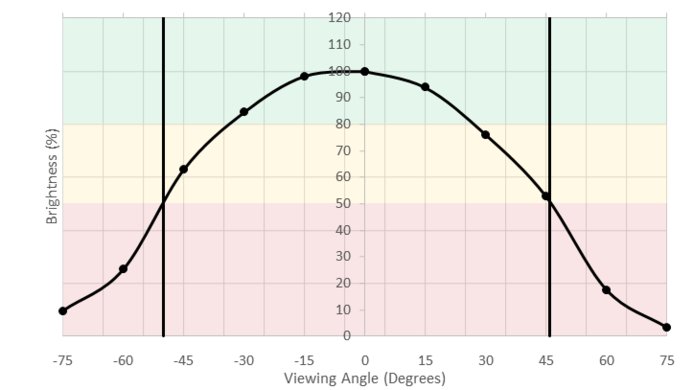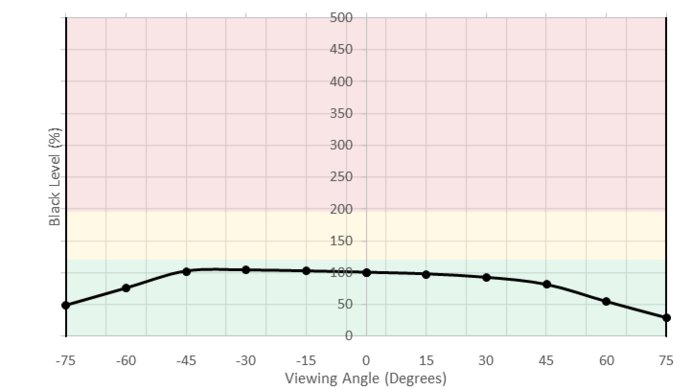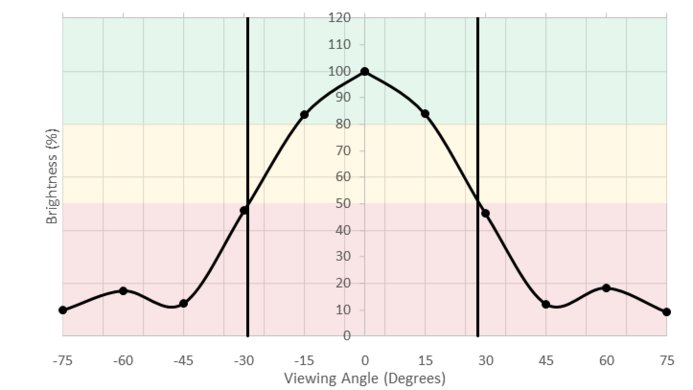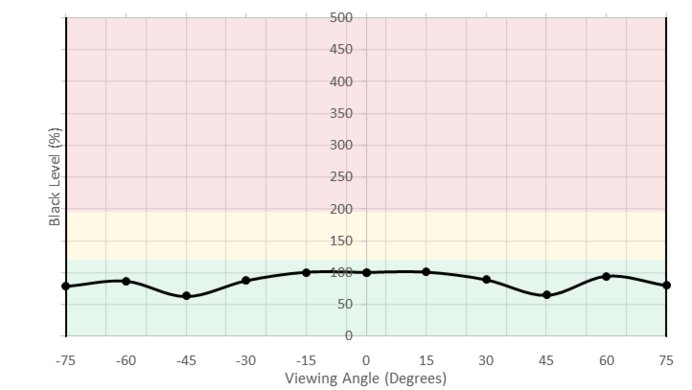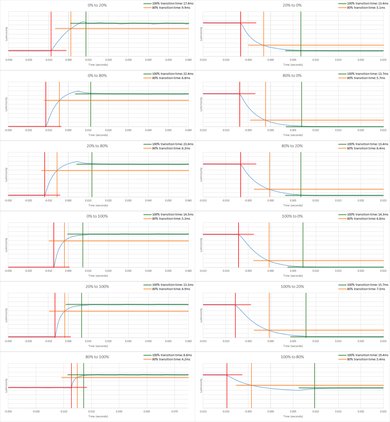The Dell P2417H is an average 1080p monitor with and IPS-type LCD, giving it wide viewing angles. Its stand offers a wide range of ergonomic adjustments and its low input lag keeps it responsive. Unfortunately, its picture quality leaves a bit to be desired and gamers might be disappointed by its standard 60Hz refresh rate.
Our Verdict
The Dell P2417H handles a varied set of usages decently. Most users will find its 24 inch size good, and its wide viewing angle can be quite practical. Unfortunately, its visible backlight bleed reduces the picture quality in a dark room, and it lacks most gaming-oriented features like adaptive sync. The picture quality is decent, but blacks do appear gray in a dark room.
-
Flicker-free
-
Wide viewing angle
-
Mediocre picture quality
-
Could be brighter
Good monitor to use in an office. The Dell P2417H's great ergonomics helps it fit in a variety of environments, and its pivot feature is particularly useful when combined with its wide viewing angle for sharing your screen with neighbors. Its flicker-free backlight is useful for long working sessions. The picture quality is also decent.
Good monitor for casual gaming. The low input lag and decent motion make it decently responsive and capable for both PC and console gaming. Unfortunately, it lacks support for higher refresh rates or adaptive sync technologies, so it is fairly basic. The picture quality is decent, but when viewed in a black room, dark scenes do appear washed out and blotchy.
Average choice for consuming different types of media. The Dell Professional P2417H's uneven blacks cause its picture quality to suffer significantly in a dark room. While it's 1080p resolution is decent, it lacks support for HDR or wider color gamuts increasingly used in modern content. When viewed from an angle the picture remains accurate, which is good.
Passable monitor for media creation. As is often seen on Dell monitors, the monitor has decent accuracy out of the box. Unfortunately, its 1080p resolution might be a bit limiting to some users, and it lacks support for larger color gamuts such as DCI-P3 and Adobe RGB. The picture quality is also only decent, and when viewed in a dark room the blacks appear blotchy.
HDR is not supported, and the monitor can't produce bright, saturated colors. Only much higher-end monitors support HDR such as the Samsung CHG70.
- 7.3 Mixed Usage
- 7.5 Office
- 7.7 Gaming
- 7.0 Multimedia
- 7.1 Media Creation
- 5.4 HDR Gaming
Changelog
Check Price
Differences Between Sizes And Variants
We tested the Dell P2417H, which is a 2017 model 24" Professional monitor. There are many other sizes within the 2017 model year of Dell Professional monitors, listed below.
If someone comes across a different type of panel or if their Dell P2417H doesn't correspond to our review, let us know and we will update the review. Note that some tests such as the gray uniformity may vary between individual units.
| Model | Size | Year | Resolution |
| P2017H | 20" | 2017 | 1600x900 |
| P2217H | 22" | 2017 | 1920x1080 |
| P2317H | 23" | 2017 | 1920x1080 |
| P2417H | 24" | 2017 | 1920x1080 |
| P2717H | 27" | 2017 | 1920x1080 |
Compared To Other Monitors

The Dell P2417H is an average monitor with an IPS panel, which works well for a range of usages. The wide viewing angles and low input lag result in versatile performance, but for specific uses such as gaming, there are better choices.
See our recommendations for the best gaming monitors under $300, the best 1080p gaming monitors, the best budget gaming monitors, and the best budget monitors.
The Dell U2415 is a bit better than the Dell P2417H. The U2415 has a slightly higher resolution than the P2417H. Overall, picture quality and performance are very similar.
The Dell P2417H and the Dell U2515H offer very similar performance. The U2515H has a higher native resolution and is a bit larger, but has worse black uniformity than the P2417H. If you want a larger screen, the U2515H is a better choice.
The Dell P2417H is slightly better than the Dell P2217H. The overall performance of the two models is very similar, but the P2417H has better black uniformity, good for darker rooms. The only real difference between the two is the size, so if you want a bit more screen real estate, the 24" P2417H is better.
The Dell P2417H is better than the Dell U2717D for most users, unless you need the larger screen size and resolution of the U2717. The P2417H has much better input lag and black uniformity than the U2717. The U2717D is brighter and has a higher native resolution, good for office use and multitasking.
If you plan to do collaborative work, then the Dell P2417H is a better choice due to better viewing angles. On the other hand, the Acer GN246HL Bbid is a better choice if you sit right in front of the screen in a brighter room. The Dell P2417H has significantly better ergonomics that allow you to place it as you like. The Dell P2417H has better input lag and thus is more responsive which is great for gaming. The Acer GN246HL, on the other hand, is slightly brighter and has a faster response time with less blur and a better refresh rate of 144Hz.
The Dell P2417H is much better than the HP 22CWA. The Dell has much better ergonomics and will not trouble you when trying to place it comfortably. The Dell also has slightly better motion blur. On the other hand, the HP 22CWA has a slightly better vertical viewing angle and marginally better contrast that improves the picture quality in a dark room.
The Dell P2417H is a 24" IPS monitor, whereas the Samsung CF398 is a VA monitor. Generally, the P2417H is better than the CF398, but the CF398 is a bit better in some cases. The P2417H has wide viewing angles and a much better, fully adjustable stand, making it a more versatile choice for most people. The CF398, on the other hand, has a faster response time, so motion looks clearer with less blur, and it supports FreeSync VRR.
The Dell P2417H is much better than the LG 24MP59G, mainly due to the much better stand. Overall, both monitors deliver similar performance. The LG 24MP59G has a better 75 Hz refresh rate and FreeSync VRR support. The LG also has an optional Black Frame Insertion feature that can help reduce persistence blur. The Dell is much more versatile, thanks to the excellent stand that has great ergonomics, so it's easier to place in an ideal viewing position.
The Dell P2417H is a bit better than the HP 27F. The P2417H is a slightly smaller screen with a 60Hz refresh rate, and no VRR support, but it has significantly better ergonomics, making it easier to place in an optimal viewing position, or for a multi-monitor setup. The P2417H is also more versatile than the HP 27F, with HDMI, DisplayPort, and VGA connections, and it can be used as a USB hub.
The Dell P2417H is better than the ASUS MX279HS, mainly due to its better ergonomics. The Dell has a stand that allows you to place it comfortably on your desk. The MX279HS, on the other hand, is larger, but the Dell can get brighter and has a faster response time that leaves a slightly smaller blur trail behind fast-moving content.
Test Results
The design of the Dell P2417H is good and the monitor looks very professional. The stand has a small footprint and supports the monitor well. It also provides a wide range of ergonomic adjustments, which is great. There is a hole in the rear of the stand for cable management and the build quality of the monitor is good.
The ergonomic adjustments are great, like other Dell monitors in the Professional (P) series. Finding a comfortable viewing position is easy due to the swivel, tilt and height adjustments. Moving the monitor to share images with colleagues is also simple.
The rear of the monitor is simple and made of plastic. It looks good, and basic cable management is possible through the stand.
The Dell P2417H has a passable contrast ratio and is similar to the contrast ratio of other Dell IPS monitors reviewed. Because if the IPS panel used here, dark room performance is not that great as blacks tend to look more gray than really black. This is why this monitor is best suited for a well-lit room, like an office space.
The monitor does not have a local dimming feature. The video is for reference only.
Decent SDR peak brightness. While most people won't have an issue with the luminance range, readability might become problematic in harsher environments where lots of reflections hit the screen.
HDR is not supported.
The Dell P2417 has a decent horizontal viewing angle. Like other IPS TVs, its black level remains constant even when viewed from the side.
Good vertical viewing angle. The blacks share the same behavior as on a horizontal axis and remain very constant. While the brightness and colors deteriorate a bit faster, they are maintained better than average allowing this monitor to provide a lot of flexibility with viewing positions.
The gray uniformity of the Dell P2417H is great, which is good for browsing websites or playing games which have large uniform areas (such as NFL games). Both sides are a bit darker than the center, but other than this no significant issues are visible on both the 50% and the 5% gray.
The black uniformity is poor. There is backlight bleed (BLB) in each corner, which can be distracting when viewing the monitor in the dark. This is still a better result than the P2217H, which was much more problematic due to the significant flashlighting.
Note that on this test picture, we can see some stuck pixels. However, this only affects the black uniformity test and note the rest of the review. We are currently testing the monitor a bit more to see what may cause this issues. We are going to update the review page to let you know what will happen in the future with this monitor.
The Dell P2417H has an impressive accuracy out of the box. We found that the most accurate picture mode was the 'Standard', which could be used as is by most people without even the need to do a calibration unless you are a professional that already have other calibrated monitors and might notice the difference between the monitor and those later ones. The second most accurate picture was the 'Custom Color', which is still almost as accurate as the 'Standard' one.
The gamma was almost right on our 2.2 target and looking at the curve, we see that it does not diverge greatly from it, besides a small bump in the around the 5 to 35 IRE, which is really not that dramatic here. As for the color temperature, the P2417H is almost right on target here to, with only 9k off, which is not perceivable anyway. This is an overall great result for this Dell monitor.
After calibration, the accuracy of the Dell Professional P2417H is excellent. Since the accuracy was already very good out of the box, only small correction needed to be done. The most visible correction that was applied is related to the color dE, which was brought down from 2.84 to 0.85, and if we look at the color space, we see that before calibration the primary were oversaturated, and are now right on target.
The gamma curve was also corrected and is now tracking much closely our target curve. Besides the gamma, the color temperature did not change too much and is still spot on.
You can download our ICC profile calibration here.
The Dell P2417H's SDR color gamut is decent. At 92.2% of the most common s.RGB color space, it shouldn't have any glaring issues while displaying most content. Unfortunately, it support for the Adobe RGB gamut is poor, so it is not recommended for those that require it for more professional usages.
Decent color volume. The Dell P2417H covers most of the widely used s.RGB volume, but due to both its low contrast ratio and limited color saturation, it is a bit below average. Since it isn't a professionally-oriented monitor, its Adobe RGB capabilities are also quite limited.
HDR color gamuts are not supported.
HDR color gamuts are not supported.
Perfect score for the Dell P2417h on our image retention test, as no retention could be picked up during our analysis of the test picture.
Response Time Normal
Response Time Fast
Very good pixel response time, good enough for watching videos with a lot of motion or playing games. Most of the blur in the photo is due to unavoidable 60Hz persistence (its a result of the static 60 fps frame) only a very short ghosting trail can be seen following the moving logo, which is good. Not all colors of this panel have the same response time; when a black object moves on a white background, a yellow trail can be seen preceding the square (white to black transition) and a blue trail can be seen following the square (black to white transition). Thus even though this monitor has a fairly fast response time, ghosting often has a color to it, which makes it more noticeable. This won't be bothersome to most people but some may find this colored ghosting distracting.
The 'Response Time Normal' setting was the most balanced; the fast setting was a little faster but added bothersome overshoot, so it's not recommended.
The Dell 2417H monitor has a flicker-free backlight, which is great for producing smooth motion when browsing the web or playing games. Unfortunately, it lacks a Black Frame Insertion feature to add optional flicker, which would otherwise be useful to clear up motion. This is expected as it's rare for a 60Hz monitor to have BFI because 60 Hz flicker is bothersome to many people.
The monitor only has a very common 60Hz refresh rate and no variable refresh rate features like FreeSync, unlike many gaming monitors. A fixed 60Hz refresh rate is good enough for most use cases but gamers may be disappointed.
Great low input lag, which should please all but the most competitive gamers. The input lag remains constant even for non-native resolutions, which is handy when gaming at a lower resolution.
The Dell P2417H monitor only has a very common 1080p resolution and 24" size, which is good enough for most use cases but all would benefit from a larger and higher resolution screen.
There is an option to keep the USB ports on when the monitor is on standby, so it can continue to act as a USB hub.
Comments
Dell P2417H: Main Discussion
Let us know why you want us to review the product here, or encourage others to vote for this product.










